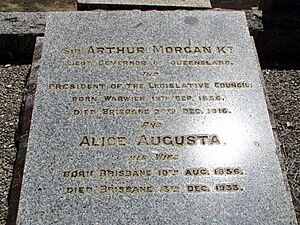Arthur Morgan (Australian politician, born 1856) facts for kids
Quick facts for kids
Sir Arthur Morgan
|
|
|---|---|

Morgan in 1908
|
|
| 16th Premier of Queensland | |
| In office 17 September 1903 – 19 January 1906 |
|
| Preceded by | Robert Philp |
| Succeeded by | William Kidston |
| Constituency | Warwick |
| Speaker of the Queensland Legislative Assembly | |
| In office 16 May 1899 – 15 September 1903 |
|
| Preceded by | Alfred Cowley |
| Succeeded by | Alfred Cowley |
| Constituency | Warwick |
| Member of the Queensland Legislative Assembly for Warwick |
|
| In office 18 July 1887 – 4 April 1896 |
|
| Preceded by | Jacob Horwitz |
| Succeeded by | Thomas Byrnes |
| In office 22 October 1898 – 19 January 1906 |
|
| Preceded by | Thomas Byrnes |
| Succeeded by | Thomas O'Sullivan |
| Member of the Queensland Legislative Council | |
| In office 19 January 1906 – 20 December 1916 |
|
| Personal details | |
| Born | 19 September 1856 Warwick, Queensland |
| Died | 20 December 1916 (aged 60) Paddington, Brisbane, Queensland, Australia |
| Resting place | Toowong Cemetery |
| Nationality | Australian |
| Political party | Ministerialist |
| Other political affiliations |
Opposition |
| Spouse | Alice Augusta Clinton |
| Relations | James Morgan (father) Arthur Morgan (son) |
| Occupation | Newspaper proprietor |
Sir Arthur Morgan (1856–1916) was an important Australian politician. He served as the Premier of Queensland from 1903 to 1906. The Premier is like the leader of the state government.
Contents
Early Life and Family
Arthur Morgan was born on September 19, 1856, in Warwick, which was then part of the Colony of New South Wales. He was the fourth son of James Morgan. His father was also a politician who represented Warwick in the Queensland Parliament.
Arthur went to a public school in Warwick. After school, he started working at the Warwick Argus newspaper. His father owned and edited this newspaper.
In 1880, Arthur Morgan married Alice Augusta Clinton. They had five sons and three daughters.
Political Career
Arthur Morgan began his public service in his hometown.
Local Government
- In 1885, he became a member of the Warwick Municipal Council.
- He served as the Mayor of Warwick twice. His first term was from 1886 to 1890. He was Mayor again in 1898.
State Parliament
- In 1887, Arthur Morgan was elected to the Legislative Assembly of Queensland. This is the main part of Queensland's parliament.
- He represented the area of Warwick until 1896.
- He was re-elected to the same seat in 1899.
- In 1899, he was chosen to be the Speaker of the Legislative Assembly of Queensland. The Speaker is like the referee of the parliament, making sure debates follow the rules.
Premier of Queensland
- In 1903, the Premier at the time, Robert Philp, resigned. No other party leader could form a new government.
- Arthur Morgan was then asked to lead a new government. He brought together a group of politicians called liberals and the Labor party.
- He resigned from his role as Speaker and became the Premier of Queensland.
- As Premier, he also held other important jobs. These included Chief Secretary, Secretary for Railways, and Vice-President of the Executive Council.
- He worked to save money for the government, which was called a "retrenchment" policy.
Later Roles
- In 1906, after the death of Sir Hugh Nelson, Arthur Morgan was appointed as the President of the Queensland Legislative Council. This is another part of the Queensland Parliament.
- He also served as the acting-governor of Queensland on two occasions. The governor is the King's representative in the state.
- In 1908, he was appointed to the important position of Lieutenant-Governor of Queensland.
Achievements and Recognition
- In 1902, Arthur Morgan published a book called Discovery and Development of the Downs. This book was about the history of the Darling Downs region in Queensland.
- He was given the title of Knight in 1907, which means he was called "Sir Arthur Morgan." This was a special honor for his public service.
Later Life and Death
In his later years, Sir Arthur Morgan's health began to decline. He passed away on December 20, 1916, at the age of 60. He is buried at Toowong Cemetery in Brisbane.


